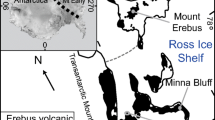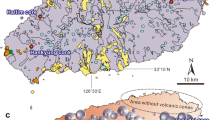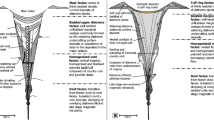Abstract
In the Izu Peninsula (Japan), the Pliocene pumice-rich Dogashima Formation (4.55 ± 0.87 Ma) displays exceptional preservation of volcaniclastic facies that were erupted and deposited in a below wave-base marine setting. It includes high-concentration density current deposits that contain clasts that were emplaced hot, indicating an eruption-fed origin. The lower part of the Dogashima 2 unit consists of a very thick sequence (<12 m) of massive grey andesite breccia restricted to the base of a submarine channel, gradationally overlain by pumice breccia, which is widespread but much thinner and finer in the overbank setting. These two breccias share similar mineralogy and crystal composition and are considered to be co-magmatic and derived from the destruction of a submarine dome by an explosive, pumice-forming eruption. The two breccias were deposited from a single, explosive eruption-fed, sustained, sea floor-hugging, water-supported, high-concentration density current in which the clasts were sorted according to their density. At the rim of the channel, localised good hydraulic sorting of clasts and stratification in the pumice breccia are interpreted to reflect local current expansion and unsteadiness rather than to be the result of hydraulic sorting of clasts during fall from a submarine eruption column and/or umbrella plume. A bimodal coarse (>1 m) pumice- and ash-rich bed overlying the breccias may be derived from delayed settling of pyroclasts from suspension. In Dogashima 1 and 2, thick cross- and planar-bedded facies composed of sub-rounded pumice clasts are intercalated with eruption-fed facies, implying inter-eruptive mass-wasting on the flank of a submarine volcano, and reworking and resedimentation by high-energy tractional currents in a below wave-base environment.














Similar content being viewed by others
References
Allen JRL (1963) The classification of cross-stratified units, with notes on their origin. Sedimentology 2:93–114
Allen SR, Freundt A (2006) Resedimentation of cold pumiceous ignimbrite into water: facies transformations simulated in flume experiments. Sedimentology 53:717–734. doi:10.1111/j.1365-3091.2006.00790.x
Allen SR, McPhie J (2000) Water-settling and resedimentation of submarine rhyolitic pumice at Yali, eastern Aegean, Greece. J Volcanol Geotherm Res 95:285–307
Allen SR, McPhie J (2009) Products of neptunian eruptions. Geology 37:639–642. doi:10.1130/G30007A.1
Allen JRL, Friend PF, Lloyd A, Wells H (1994) Morphodynamics of intertidal dunes: a year-long study at Lifeboat Station Bank, Wells-next-the-Sea, Eastern England. Philos Trans R Soc A 347:291–344
Allen SR, Fiske RS, Cashman KV (2008) Quenching of steam-charged pumice; implications for submarine pyroclastic volcanism. Earth Planet Sci Lett 274:40–49. doi:10.1016/j.epsl.2008.06.050
Allen SR, Fiske RS, Tamura Y (2010) Effects of water depth on pumice formation in submarine domes at Sumisu, Izu-Bonin Arc, western Pacific. Geology 38:391–394. doi:10.1130/G30500.1
Branney MJ, Kokelaar P (2002) Pyroclastic density currents and the sedimentation of ignimbrites. Geological Society, London
Cantelli A, Johnson S, White JDL, Parker G (2008) Sediment sorting in the deposits of turbidity currents created by experimental modeling of explosive subaqueous eruptions. J Geol 116:76–93
Carey RJ, Wysoczanski R, Wunderman R, Jutzeler M (2014) Discovery of the largest historic silicic submarine eruption. Eos Trans AGU 95:157–159. doi:10.1002/2014EO190001
Cas RAF, Wright JV (1991) Subaqueous pyroclastic flows and ignimbrites: an assessment. Bull Volcanol 53:357–380. doi:10.1007/BF00280227
Cas RAF, Allen RL, Bull SW, Clifford BA, Wright JV (1990) Subaqueous, rhyolitic dome-top tuff cones: a model based on the Devonian Bunga Beds, southeastern Australia and a modern analogue. Bull Volcanol 52:159–174
Cashman KV, Fiske RS (1991) Fallout of pyroclastic debris from submarine volcanic eruptions. Science 253:275–280. doi:10.1126/science.253.5017.275
DiMarco MJ, Lowe DR (1989) Shallow-water volcaniclastic deposition in the Early Archean Panorama Formation, Warrawoona Group, eastern Pilbara Block, Western Australia. Sediment Geol 64:43–63
Fisher RV (1961) Proposed classification of volcaniclastic sediments and rocks. Geol Soc Am Bull 72:1409–1414. doi:10.1130/0016-7606(1961)72[1409:PCOVSA]2.0.CO;2
Fisher RV (1983) Flow transformations in sediment gravity flows. Geology 11:273–274
Fiske RS (1969) Recognition and significance of pumice in marine pyroclastic rocks. Geol Soc Am Bull 80:1–8. doi:10.1130/0016-7606(1969)80[1:RASOPI]2.0.CO;2
Fiske RS, Matsuda T (1964) Submarine equivalents of ash flows in the Tokiwa Formation, Japan. Am J Sci 262:76–106
Fiske RS, Cashman KV, Shibata A, Watanabe K (1998) Tephra dispersal from Myojinsho, Japan, during its shallow submarine eruption of 1952–1953. Bull Volcanol 59:262–275. doi:10.1007/s004450050190
Fiske RS, Naka J, Iizasa K, Yuasa M, Klaus A (2001) Submarine silicic caldera at the front of the Izu-Bonin Arc, Japan; voluminous seafloor eruptions of rhyolite pumice. Geol Soc Am Bull 113:813–824
Gardner JV (2010) The West Mariana Ridge, western Pacific Ocean: geomorphology and processes from new multibeam data. Geol Soc Am Bull 122:1378–1388. doi:10.1130/B30149.1
Geological Survey of Japan (2010) Seamless digital geological map of Japan 1:200,000. In: AIST GSJ (ed) Research information database DB084. Geol. Surv. Jpn. AIST, Japan
Gifkins CC, McPhie J, Allen RL (2002) Pumiceous rhyolitic peperite in ancient submarine volcanic successions. J Volcanol Geotherm Res 114:181–203. doi:10.1016/S0377-0273(01)00284-0
Gordee SM, McPhie J, Allen SR (2008) Facies mapping of volcanic and sedimentary facies of a partly extrusive submarine cryptodome, Mio-Pliocene Shirahama Group, Izu Peninsula, Japan. In: IAVCEI General Assembly, Iceland
Goto Y, Tsuchiya N (2004) Morphology and growth style of a Miocene submarine dacite lava dome at Atsumi, northeast Japan. J Volcanol Geotherm Res 134:255–275. doi:10.1016/j.jvolgeores.2004.03.015
Head JW, Wilson L (2003) Deep submarine pyroclastic eruptions: theory and predicted landforms and deposits. J Volcanol Geotherm Res 121:155–193
Huchon P, Kitazato H (1984) Collision of the Izu Block with central Japan during the quaternary and geological evolution of the Ashigara area. Tectonophysics 110:201–210
Ibaraki M (1981) Geologic ages of “Lepidocyclina” and Miogypsina horizons in Japan as determined by planktonic foraminifera. In: Ikebe N, Chiji M, Tsuchi R, Morozumi Y, Kawata T (eds) IGCP-114; International workshop on Pacific Neogene biostratigraphy; 6th international working group meeting, Osaka, Japan, Nov 25–29, 1981. Osaka Mus. Nat. Hist., Osaka, Japan (JPN), p 118–119
Ingram RL (1954) Terminology for the thickness of stratification and parting units in sedimentary rocks. Geol Soc Am Bull 65:937–938. doi:10.1130/0016-7606(1954)65[937:TFTTOS]2.0.CO;2
Jutzeler M (2012) Characteristics and origin of subaqueous pumice-rich pyroclastic facies: Ohanapecosh Formation (USA) and Dogashima Formation (Japan). Ph.D. thesis, University of Tasmania, Hobart, Australia, Hobart, Australia
Jutzeler M, Proussevitch AA, Allen SR (2012) Grain-size distribution of volcaniclastic rocks 1: a new technique based on functional stereology. J Volcanol Geotherm Res 239–240:1–11. doi:10.1016/j.jvolgeores.2012.05.013
Jutzeler M, McPhie J, Allen SR (2014a) Facies architecture of a continental, below-wave-base volcaniclastic basin: the Ohanapecosh Formation, Ancestral Cascades arc (Washington, USA). Geol Soc Am Bull 126:352–376. doi:10.1130/B30763.1
Jutzeler M, Marsh R, Carey RJ, White JDL, Talling PJ, Karlstrom L (2014b) On the fate of pumice rafts formed during the 2012 Havre submarine eruption. Nat Commun 5:3660. doi:10.1038/ncomms4660
Kano K-I (1983) Structures of submarine andesitic volcano—an example in the Neogene Shirahama group in the southern part of the Izu Peninsula, Japan. Geosci Rep Shizuoka Univ 8:9–37
Kano K-I (1989) Interactions between andesitic magma and poorly consolidated sediments: examples in the Neogene Shirahama Group, South Izu, Japan. J Volcanol Geotherm Res 37:59–75
Kano K (1991) Volcaniclastic sedimentation in a shallow-water marginal basin: the Early Miocene Koura Formation, SW Japan. Sediment Geol 74:309–321
Kano K (1996) A Miocene coarse volcaniclastic mass-flow deposit in the Shimane Peninsula, SW Japan: product of a deep submarine eruption? Bull Volcanol 58:131–143. doi:10.1007/s004450050131
Kano K (2003) Subaqueous pumice eruptions and their products; a review. In: White JDL, Smellie JL, Clague DA (eds) Explosive subaqueous volcanism. AGU, Washington, pp 213–230
Kano K, Orton GJ, Kano T (1994) A hot Miocene subaqueous scoria-flow deposit in the Shimane Peninsula, SW Japan. J Volcanol Geotherm Res 60:1–14
Kano K, Yamamoto T, Ono K (1996) Subaqueous eruption and emplacement of the Shinjima Pumice, Shinjima (Moeshima) Island, Kagoshima Bay, SW Japan. J Volcanol Geotherm Res 71:187–206
Kato Y (1987) Woody pumice generated with submarine eruption. Chishitsugaku Zasshi J Geol Soc Jpn 93:11–20
Kneller BC, Branney MJ (1995) Sustained high-density turbidity currents and the deposition of thick massive sands. Sedimentology 42:607–616
Kokelaar P, Raine P, Branney MJ (2007) Incursion of a large-volume, spatter-bearing pyroclastic density current into a caldera lake: Pavey Ark ignimbrite, Scafell caldera, England. Bull Volcanol 70:23–54. doi:10.1007/s00445-007-0118-5
Komar PD (1971) Hydraulic jumps in turbidity currents. Geol Soc Am Bull 82:1477–1487. doi:10.1130/0016-7606(1971)82[1477:HJITC]2.0.CO;2
Le Bas MJ, Le Maitre RW, Streckeisen A, Zanettin B (1986) A chemical classification of volcanic rocks based on the total alkali-silica diagram. J Petrol 27:745–750. doi:10.1093/petrology/27.3.745
Lowe DR (1982) Sediment gravity flows: II. Depositional models with special reference to the deposits of high-density turbidity currents. J Sediment Petrol 52:279–297
Manville V, Wilson CJN (2004) Vertical density currents: a review of their potential role in the deposition and interpretation of deep-sea ash layers. J Geol Soc (London, UK) 161:947–958. doi:10.1144/0016-764903-067
Manville V, White JDL, Houghton BF, Wilson CJN (1998) The saturation behaviour of pumice and some sedimentological implications. Sediment Geol 119:5–16. doi:10.1016/S0037-0738(98)00057-8
Manville V, Segschneider B, White JDL (2002) Hydrodynamic behaviour of Taupo 1800a pumice: implications for the sedimentology of remobilized pyroclasts. Sedimentology 49:955–976
Matsumoto R, Katayama T, Iijima A (1985) Geology, igneous activity, and hydrothermal alteration in the Shimoda district, southern part of Izu Peninsula, central Japan. J Geol Soc Jpn 91:43–63
McKee ED, Weir GW (1953) Terminology for stratification and cross stratification in sedimentary rocks. Geol Soc Am Bull 64:381–389
McPhie J, Allen RL (2003) Submarine, silicic, syn-eruptive pyroclastic units in the Mount Read Volcanics, western Tasmania; influence of vent setting and proximity on lithofacies characteristics. In: White JDL, Smellie JL, Clague DA (eds) Explosive subaqueous volcanism. AGU, Washington, pp 245–258
McPhie J, Doyle M, Allen R (1993) Volcanic textures. ARC - Centre of Excellence in Ore Deposits University of Tasmania, Hobart
Mulder T, Alexander J (2001) The physical character of subaqueous sedimentary density flow and their deposits. Sedimentology 48:269–299. doi:10.1046/j.1365-3091.2001.00360.x
Piper DJW, Normark WR (2009) Processes that initiate turbidity currents and their influence on turbidites; a marine geology perspective. J Sediment Res 79:347–362. doi:10.2110/isr.2009.046
Postma G, Nemec W, Kleinspehn KL (1988) Large floating clasts in turbidites: a mechanism for their emplacement. Sediment Geol 58:47–61
Pyle DM (1989) The thickness, volume and grainsize of tephra fall deposits. Bull Volcanol 51:1–15
Raos AM, McPhie J (2003) The submarine record of a large-scale explosive eruption in the Vanuatu Arc; approximately 1 Ma Efate pumice formation. In: White JDL, Smellie JL, Clague DA (eds) Explosive subaqueous volcanism. AGU, Washington, pp 273–284
Reynolds MA, Best JG, Johnson RW (1980) 1953–57 eruption of Tuluman Volcano; rhyolitic volcanic activity in the northern Bismarck Sea. Geological Survey of Papua New Guinea, Port Moresby
Rivera J, Lastras G, Canals M, Acosta J, Arrese B, Hermida N, Micallef A, Tello O, Amblas D (2013) Construction of an oceanic island: insights from the El Hierro (Canary Islands) 2011–2012 submarine volcanic eruption. Geology 41:355–358
Sawamura K, Sumi K, Ono K, Moritani T (1970) Geology of the Shimoda District; quadrangle series, scale 1:50,000, Tokyo (8) No. 105. Geological Survey of Japan
Schneider JL, Le Ruyet A, Chanier F, Buret C, Ferrière J, Proust JN, Rosseel JB (2001) Primary or secondary distal volcaniclastic turbidities: how to make the distinction? An example from the Miocene of New Zealand (Mahia Peninsula, North Island). Sediment Geol 145:1–22
Shanmugam G (2002) Ten turbidite myths. Earth Sci Rev 58:311–341. doi:10.1016/S0012-8252(02)00065-X
Shanmugam G (2008)Deep-water bottom currents and their deposits. In: Rebesco M, Camerlenghi A (eds) Contourites. Elsevier Science, Amsterdam, pp 59–81
Sohn YK (1997) On traction-carpet sedimentation. J Sediment Res 67:502–509
Sohn YK, Chough SK (1993) The Udo tuff cone, Cheju Island, South Korea; transformation of pyroclastic fall into debris fall and grain flow on a steep volcanic cone slope. Sedimentology 40:769–786
Stewart AL, McPhie J (2004) An Upper Pliocene coarse pumice breccia generated by a shallow submarine explosive eruption, Milos, Greece. Bull Volcanol 66:15–28
Sumner EJ, Talling PJ, Amy LA, Wynn RB, Stevenson CJ, Frenz M (2012) Facies architecture of individual basin-plain turbidites: comparison with existing models and implications for flow processes. Sedimentology 59:1850–1887. doi:10.1111/j.1365-3091.2012.01329.x
Sumner EJ, Peakall J, Parsons DR, Wynn RB, Darby SE, Dorrell RM, McPhail SD, Perrett J, Webb A, White D (2013) First direct measurements of hydraulic jumps in an active submarine density current. Geophys Res Lett 40:2013GL057862. doi:10.1002/2013GL057862
Talling PJ, Amy LA, Wynn RB (2007) New insight into the evolution of large-volume turbidity currents: comparison of turbidite shape and previous modelling results. Sedimentology 54:737–769
Talling PJ, Masson DG, Sumner EJ, Malgesini G (2012) Subaqueous sediment density flows: depositional processes and deposit types. Sedimentology 59:1937–2003. doi:10.1111/j.1365-3091.2012.01353.x
Tamura Y (1990) Mode of emplacement and petrogenesis of volcanic rocks of the Shirahama Group, Izu Peninsula, Japan. Ph.D. thesis, University of Tokyo, Japan
Tamura Y (1994) Genesis of island arc magmas by mantle-derived bimodal magmatism: evidence from the Shirahama Group, Japan. J Petrol 35:619–645. doi:10.1093/petrology/35.3.619
Tamura Y (1995) Liquid lines of descent of island arc magmas and genesis of rhyolites: evidence from the Shirahama Group, Japan. J Petrol 36:417–434. doi:10.1093/petrology/36.2.417
Tamura Y, Koyama M, Fiske RS (1991) Paleomagnetic evidence for hot pyroclastic debris flow in the shallow submarine Shirahama Group (Upper Miocene-Pliocene), Japan. J Geophys Res 96:21779–21787. doi:10.1029/91JB02258
Tani K, Fiske RS, Tamura Y, Kido Y, Naka J, Shukuno H, Takeuchi R (2008) Sumisu volcano, Izu-Bonin arc, Japan: site of a silicic caldera-forming eruption from a small open-ocean island. Bull Volcanol 70:547–562
Tani K, Fiske RS, Dunkely DJ, Ishizuka O, Oikawa T, Isobe I, Tatsumi Y (2011) The Izu Peninsula, Japan: Zircon geochronology reveals a record of intra-oceanic rear-arc magmatism in an accreted block of Izu-Bonin crust. Earth Planet Sci Lett. doi:10.1016/j.epsl.2010.12.052
Taylor B (1992) Rifting and the volcanic-tectonic evolution of the Izu-Bonin-Mariana Arc. Proc Ocean Drill Program Sci Results 126:627–652
Valentine PC, Cooper RA, Uzmann JR (1984) Submarine sand dunes and sedimentary environments in Oceanographer Canyon. J Sediment Petrol 54:704–715
Watt SFL, Talling PJ, Vardy ME, Masson DG, Henstock TJ, Huehnerbach V, Minshull TA, Urlaub M, Lebas E, Le Friant A, Berndt C, Crutchley GJ, Karstens J (2012) Widespread and progressive seafloor-sediment failure following volcanic debris avalanche emplacement: landslide dynamics and timing offshore Montserrat, Lesser Antilles. Mar Geol 323–325:69–94
White JDL (2000) Subaqueous eruption-fed density currents and their deposits. Precambrian Res 101:87–109. doi:10.1016/S0301-9268(99)00096-0
White JDL, Manville V, Wilson CJN, Houghton BF, Riggs NR, Ort M (2001) Settling and deposition of AD 181 Taupo pumice in lacustrine and associated environments. In: White JDL, Riggs NR (eds) Volcaniclastic sedimentation in lacustrine settings. Blackwell Science, Oxford, pp 141–150
White JDL, Smellie JL, Clague DA (2003) Introduction: a deductive outline and topical overview of subaqueous explosive volcanism. In: White JDL, Smellie JL, Clague DA (eds) Explosive subaqueous volcanism. AGU, Washington, pp 1–23
Wright IC (1996) Volcaniclastic processes on modern submarine arc stratovolcanoes: sidescan and photographic evidence from the Rumble IV and V volcanoes, southern Kermadec Arc (SW Pacific). Mar Geol 136:21–39
Wright IC (2001) In situ modification of modem submarine hyaloclastic/pyroclastic deposits by oceanic currents: an example from the southern Kermadec arc (SW Pacific). Mar Geol 172:287–307
Wright IC, Gamble JA (1999) Southern Kermadec submarine caldera arc volcanoes (SW Pacific): caldera formation by effusive and pyroclastic eruption. Mar Geol 161:207–227
Yamada E, Sakaguchi K (1987) Stratigraphy and geological structure of the Neogene formations, southwestern part of the Izu Peninsula, Japan. Chishitsu Chosajo Geppo Bull Geol Surv Jpn 38:357–383
Acknowledgments
This study was supported by the Australian Research Council and is part of the PhD thesis of M.J. We thank R. Fiske, M. Ort, J.D.L. White and S.M. Gordee for helpful discussions on this paper. V. Manville, K. Kano, R.A.F. Cas and R. Fiske thoroughly reviewed an earlier manuscript. K.-I. Kano is thanked for his help with the fieldwork in Japan; J.M. and M.J. are grateful to the Shimoda Marine Research Center (Japan) for accommodation. S. Meffre, K. Goemann and P. Robinson conducted part of the chemical and geochronological analyses.
Author information
Authors and Affiliations
Corresponding author
Additional information
Editorial responsibility: V. Manville
Electronic supplementary material
Below is the link to the electronic supplementary material.
Online Resource 1
Major and trace element compositions analysed by XRF for various clasts of the Dogashima and Matsuzaki formations. Concentrations recalculated to 100 wt.% anhydrous. (XLSX 13 kb)
Online Resource 2
Composition of major elements in plagioclase phenocrysts and microlites in white pumice and grey andesite clasts in Dogashima 2; analysed on a Cameca 100X electron microprobe. (XLSX 93 kb)
Online Resource 3
U/Pb analyses on zircons by LA-ICP-MS; data and Concordia. (XLSX 136 kb)
Rights and permissions
About this article
Cite this article
Jutzeler, M., McPhie, J. & Allen, S.R. Submarine eruption-fed and resedimented pumice-rich facies: the Dogashima Formation (Izu Peninsula, Japan). Bull Volcanol 76, 867 (2014). https://doi.org/10.1007/s00445-014-0867-x
Received:
Accepted:
Published:
DOI: https://doi.org/10.1007/s00445-014-0867-x




